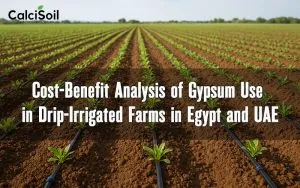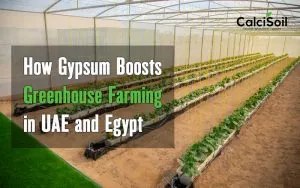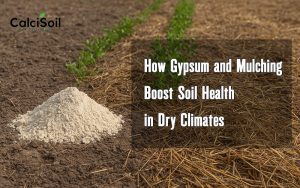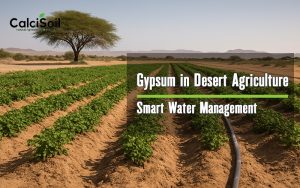
Agricultural gypsum application methods
Agricultural gypsum application can be done using several methods depending on the soil conditions and the desired outcome:
Injection into irrigation water
Gypsum can be injected as a saturated solution or suspension into the irrigation system to add calcium as part of an amendment program for sodic soils or to increase the salinity of low-EC irrigation water to improve infiltration.
Special solution grade gypsum and equipment is required to provide the suspension and solubility required for this type of application.
As little as 0.85 t/ha applied in the water at one irrigation can have more of an effect than 2.5 t/ha of broadcast application.
In some applications, irrigation water and a gypsum slurry may be injected directly into the soil and to the roots of plants using a drip irrigation system.
Use caution when injecting gypsum into irrigation water high in bicarbonate (HCO3 ≥ 92 ppm). Such waters usually require a lowering of pH (≤ 6.5) to avoid drip emitter clogging due to the formation of solid calcium carbonate.
The gypsum should be injected upstream of filters and acid may be needed to lower pH if bicarbonates are high.
Broadcast application
Gypsum can be spread on the soil surface using a fertilizer spreader. Rain or irrigation will dissolve the gypsum. For best results, it should be applied well before sowing to maximize subsoil water storage, especially under dryland conditions. The spreader should have features like a stainless steel box, twin spinners, and a wide delivery chain or belt.
After broadcasting, the gypsum should be well mixed into the top 5 cm of soil using tillage. This improves soil structure, aeration, drainage and plant growth.
Broadcast application is suitable for heavy clay soils, with an application rate of approximately 500g per square metre.
Incorporation into topsoil
For sodic soils, 75% of the required gypsum can be spread and mixed into the top 12 inches, followed by 25% mixed into the top 4 inches. For intermediate-textured sodic soils, mixing into the top 6 inches may be adequate.
Deep placement
Gypsum can be injected as concentrated suspensions into the subsoil or deeply mixed in, but this requires expensive machinery.
The deep placement method for applying agricultural gypsum involves incorporating the gypsum into the subsoil at depths of 15-40cm using specialized machinery. This technique aims to ameliorate subsoil constraints and improve soil physicochemical properties in the root zone.
Key points about deep placement of gypsum:
It is done using a 3-D ripping machine that can deliver gypsum and other amendments at depths of 10-30cm.
Deep placement of gypsum reduced soil pH by 0.86 units and exchangeable sodium percentage (ESP) by 12% in the 20-30cm subsoil layer compared to the control.
Gypsum can be placed in wide strips around runoff prone areas or in effluent treated paddocks to reduce nutrient losses to waterways.
Deep placement via shrinkage cracks appears to be the most economic approach for applying gypsum.
In contrast to surface application, deep placement allows the gypsum to directly target and ameliorate subsoil constraints such as sodicity, acidity, and poor structure that limit root growth and crop productivity. The deep placement method shows promise for improving the management of sodic soils in Australia.
Dissolving in irrigation water
Finely crushed gypsum can be dissolved in irrigation water and applied that way.
Agricultural Gypsum Application to hay fields
Gypsum can be applied to hay fields after cutting. The recommended amount of gypsum to apply to hay fields typically ranges from 1 to 2 tons per acre, every one to two years. This application rate helps improve soil structure, enhance water percolation, and promote deeper rooting of plants, ultimately benefiting crop yields and soil health. The cost of a typical gypsum application is around $30 to $50 per acre, making it a relatively low-cost mineral with significant benefits for soil quality and crop production.
The optimal agricultural gypsum application method depends on several key factors:
Whether the agriculture is dryland or irrigated
Whether the topsoil or subsoil (or both) needs to be treated
The nature and extent of the soil problem (e.g. sodic soils, surface crusting, poor tilth)








4 Responses
Thank you for sharing with us, I think this website genuinely stands out : D
We hope that you found it to be beneficial.